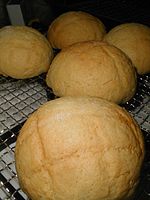A melonpan (メロンパン, meronpan) (also known as melon pan, melon bun or melon bread) is a type of Japanese sweetbun that is well known across the country and widely popular throughout China and Taiwan. The sweetbun is made from an enriched dough covered in a thin layer of crisp cookie dough. Their appearance resembles a melon, such as a rock melon (cantaloupe). They are not traditionally melon flavored,[1] but in recent times, it has become popular for manufacturers to add melon flavoring to melon bread. Variations exist, including some with a few chocolate chips between the cookie layer and the enriched dough layer, and non-melon versions flavored with caramel, maple syrup, chocolate, or other flavors, sometimes with syrup, whipped or flavored cream, or custard as a filling. In the case of such variations, the name may drop the word "melon", instead replacing it with the name of the contents (such as "maple pan" for a maple syrup flavored bread) or may keep it despite the lack of melon flavor (such as "chocolate melon pan").
 | |
| Alternative names |
|
|---|---|
| Type | Sweet bun |
| Place of origin | Japan |
| Region or state | East Asia |
| Main ingredients | |
The name has a dual etymology, since "melon" is a loan word from English, while "pan"[2] is from the Portuguese word for bread.
In parts of the Kansai, Chūgoku, and Shikoku regions, a variation with a radiating line pattern is called "sunrise", and many residents of these regions call even the cross-hatched melon pan "sunrise".[3]
Melonpan and pineapple bun from Hong Kong are very similar. By comparison, the Japanese style is lighter in weight and taste, slightly drier and has a firmer outer layer (including top cookie crust) which resists flaking, unlike its Hong Kong counterpart, whose top cookie crust tends to flake easily. The Hong Kong version is also moister, and is generally soft on the outside and inside, with a stronger butter flavour.
History
There are several competing theories about melonpan's origin.
- One theory is that after World War I, Okura Kihachiro brought an Armenian baker, Hovhannes Ghevenian, also known as Ivan Sagoyan, to Tokyo. Sagoyan worked at the Imperial Hotel in Tokyo and invented the bread following Russian, French, and Viennese baking techniques. However, if Sagoyan was indeed the inventor, he did not refer to the bread as "melonpan".[4][5][6]
- Alternatively, the bread (specifically its shape and method of production) invented by the bakery owner Kikujiro Mitsugawa in 1930 could have been melonpan. Records from the time describe covering the bread dough with cake dough and adding flavors like coffee or banana, albeit with no mention of the bread's name.[7]
- Another theory states that the round bread with biscuit dough on top called "Sunrise" sold by Kinseido's Obama branch in Kobe in the 1930s was the first melonpan in Japan.
- Other theories point to origins in the Mexican pastry conchas and the German pastry Streuselkuchen, which were introduced to Japan from the United States following World War II.[8]
Gallery
- Homemade melon buns
- Melonpan variety containing chocolate chips
- Jumbo Melonpan for sale in Asakusa



